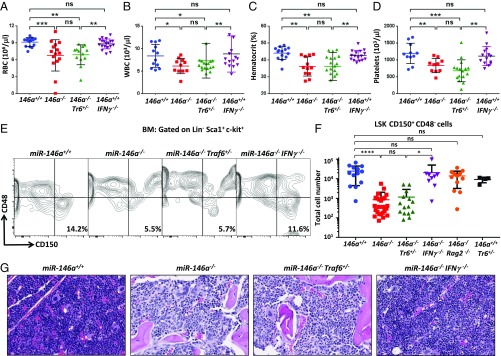Fig. 5.
BM failure in miR-146a−/− mice is rescued by IFN-γ ablation, but not by lowering the Traf6 gene dose. (A–D) Complete blood count tests of terminal blood collected from 9- to 10-mo-old female miR-146+/+, miR-146a−/−, miR-146a−/−Traf6+/−, and miR-146a−/−IFN-γ−/− mice (n ≥ 10 for each group). (A) Absolute red blood counts. (B) Absolute white blood counts (WBC). (C) Blood hematocrit. (D) Absolute platelet counts. (E and F) Analysis of LT-HSC cells from the BM of 9- to 10-mo-old female miR-146+/+, miR-146a−/−, miR-146a−/−Traf6+/−, and miR-146a−/−IFNγ−/− mice. Lineage depleted cells (Lin−) from BM were analyzed by FACS using anti–c-kit, -Sca1, -CD150, -CD48 antibodies. (E) Representative FACS analysis using the SLAM markers to identify the LT-HSC population as Lin−c-kit+Sca1+CD150+CD48−. Numbers indicate frequency of LT-HSCs. (F) Quantification of LT-HSCs using the SLAM marker system in 9- to 10-mo-old miR-146+/+, miR-146a−/−, miR-146a−/−Traf6+/−, miR-146a−/−IFNγ−/−, miR-146a−/−Rag2−/−, and miR-146a+/+Traf6+/− BM (n ≥ 13 for all groups except miR-146a+/+Traf6+/− n = 4). (G) Representative H&E-stained sections of tibias from 9- to 10-mo-old female miR-146+/+, miR-146a−/−, miR-146a−/−Traf6+/−, and miR-146a−/−IFN-γ−/− mice. Note that BM in miR-146a−/− and miR-146a−/−Traf6+/− mice is markedly hypocellular, whereas miR-146a−/−IFN-γ−/− BM appears closer to normal and is only minimally hypocellular. Data are shown as mean ± SD. P values were calculated using standard one-way ANOVA tests. *P ≤ 0.05; **P ≤ 0.01; ***P ≤ 0.001; ****P ≤ 0.0001; ns, not significant. (Magnification: 40×.)

